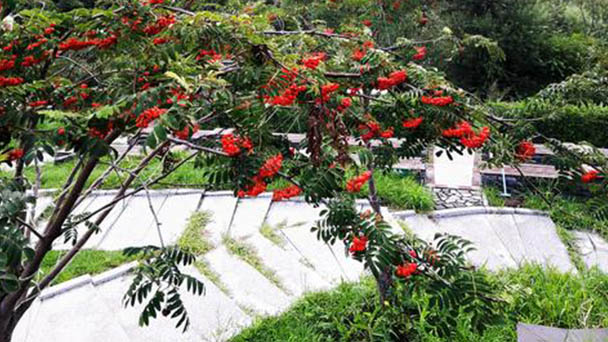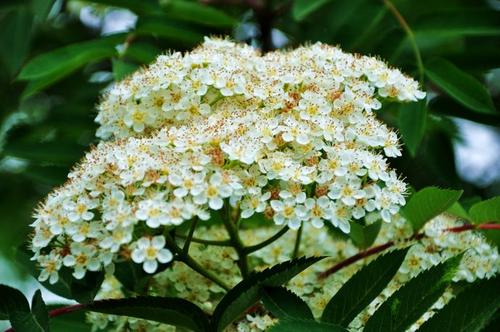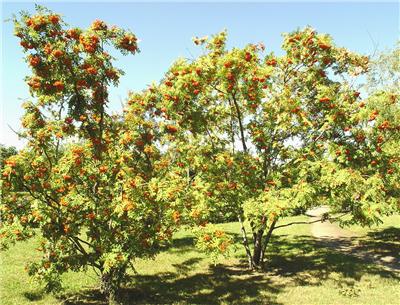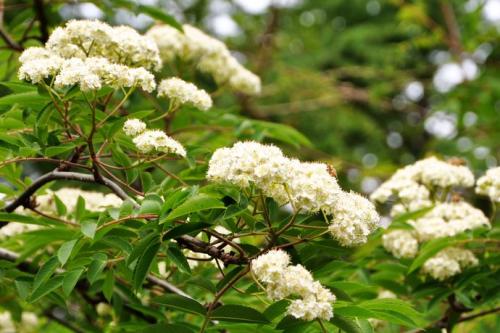Rowan tree (mountain ash) profile
Written by Maggie
Mar 24 2021

Rowan is also called mountain ash, Sorbus pohuashanensis. The trunk is straight, twigs sparsely piloted. Leaves are opposite or nearly opposite, sometimes whorled, broadly ovate, nearly equal in length and width, native to the Yangtze River valley and northern regions; In the right place, Rowan grows quite fast, spring full of white flowers, autumn and winter hanging like beans; Wood is white slightly soft, can be made of furniture. Making the bottom of the piano, the so-called 'Tongtian Catalpa Land' is also. Young leaves are edible; Leaves or bark can be used as pesticides, can kill rice borer, rice planthopper; Rowan seeds contain 10% fatty oil;Leaves containing 2% p-hydroxybenzoic acid), has a significant diuretic effect, can be used as a diuretic, treatment of kidney disease, nephrocystitis, cirrhosis, ascites.
Rowan picture

Morphological characteristics of rowan
Rowan is a deciduous tree, up to 10 m tall, branchlets stout, cylindrical, grayish-brown, with small grayish-white lenticels, young shoots villous, gradually falling off, glabrous when old, winter buds long, oblong ovate, apex acuminate, with several reddish-brown scales and densely covered with grayish-white hairs. Odd pinnate compound leaves, 12-20 cm inside petiole, 2.5-5 cm long petiole; Small blade 5-7 on, interval of 1-2.5 cm, base and the top of the small leaf is a bit small, often ovoid lanceolate or elliptic to lanceolate, 3-5 cm long, 1.4 1.8 cm wide, apex acute or acuminate, base oblique rounded, margin sharply serrate, base or middle under nearly all over, mask on sparse hairs or nearly glabrous, under the pale, have sparse or dense hairs, or glabrous, lateral veins 9-16 pairs, at the edge of the blade slightly curved, midrib raised significantly below; Leaf axis of Rowan is white tomentose, nearly glabrous when old; Stipules are herbaceous, persistent, broadly ovate, with coarsely sharp serrate.
Inflorescences of Rowan are with many dense flowers, peduncles and peduncles densely white tomentose, falling off gradually as they grow; Pedicels are 3 -- 4 mm long; Flowers are 6-8 mm in diameter; Calyx tube is campanulate, villous or sub glabrous outside, villous inside; Sepals are triangular, apex acute, villous on both inner and outer surfaces; Petals are broadly ovate or suborbicular, 3.5 -- 5 mm long, 3 -- 4 mm wide, apex obtuse, white, inner surface puberulent; Rowan has 20 stamens, nearly as long as petals; Rowan has 3 styles, pubescent at base, shorter than stamens. Fruit is subglobose, 6 -- 8 mm in diam., red or orange red, with persistent closed sepals.
Ecological habits of rowan
Rowan likes light and is slightly shade tolerant, and has strong cold resistance. Cultivated on the top of Mount Tai, Rowan has good growth performance, strong adaptability, developed root system, and not strict requirements on soil. It is better to use moist and fertile sandy loam.
Rowan prefers moist soil and grows along the shady slopes of valleys and streams. Rowan has shade resistance, strong cold resistance, sandy loam is better. Rowan was often born on the hillside or valley in the forest, more cultivated near villages and on both sides of the road, wild people are not visible, altitude (500)1900-2500 meters.
How to grow and care for rowan
Watering
Water condition is crucial to the growth of Rowan seedlings, autumn sowing seedling, if to the next year in late April days does not rain, the soil layer is dry, it is necessary to water, keep the bed surface moist, to the early 10 days of May seedlings have been out, then remove the shading net, according to the weather and soil moisture conditions, timely watering. The same management method is adopted for spring sowing and seedling breeding.
Scarification weeding
Seedling out of Rowan should be timely soil, weeding, keep the bed surface clean, loose soil, permeable to water and air, promote seedling growth. Especially in July, seedlings into the rapid growth period, more weeds, to remove in time. Combined with soil weeding, can be appropriate thinning, between the dense and weak seedlings, ensure ventilation and light.
Fertilization
Adopt the principle of the amount of small times, in the growth period can be top dressing 2 ~ 3 times, each time per acre top dressing urea or diammonium phosphate 25kg, choose after rain or irrigation after topdressing, into August, should spray 0.2 potassium dihydrogen phosphate solution, 10 days 1 times, spray 2 times, to promote the seedlings as soon as possible, in order to enhance the wintering ability. Rowan seedlings are well lignified, which can be safely wintered without cold protection;If the degree of lignification of seedlings is poor, it should be covered with soil winter.
How Rowan propagtes
Sowing propagation, seeds after the first sand accumulation, spring sowing.
Rowan fruit ripens in autumn, but can persist on trees, and seed collection can be extended to winter.

Species taxonomy of rowan
Common species
Beijing Rowan s.d. iscolor (Maxim.) Maxim.
The species differs from Rowan by branchlets purplish brown, glabrous, leaflets rectangular oblanceolate, smooth glabrous on both sides of the leaves, stipules leathery, persistent. Complex cymbidium, more sparse, glabrous flower, white flowers.Pears ovate, white or yellow.
Water elm RowanS. Alnifolia K.K och
Rowan this species in the genus is a simple type, leaves small trees, to 20 m tall, dry skin dark brown, smooth, no crack, branchlets dark brown or dark brown, with pale lenticels dot, leaves simple, alternate, elliptical leaves ovate, 5-10 cm long, 3-6 cm wide, margin irregular sharp heavy toothed, two sides glabrous, lateral veins 6-10 pairs, petiole 1.5 3.0 cm long, complex umbrella inflorescence, flowers white, stamens shorter than petals, pome elliptic, red or yellow, calyx early fall, residual calyx round spot mark. Wild is common in the mountains of North China above 500 meters. The stem, bark and fruit are used as medicine.Pick in autumn and dry.
Rowan's distribution area
Rowan is distributed in Northeast China, North China, Gansu, Xinjiang and so on.
Rowan is distributed in Hebei, Henan, Shanxi, Shandong, Gansu, Inner Mongolia and other places in China, about 1500-2500 meters above sea level, wild in sunny slope forest.Deciduous trees. Rowan is produced in Heilongjiang, Jilin, Liaoning, Inner Mongolia, Hebei, Shanxi, Gansu, Shandong.Yangtze River Basin and the north of the region; .
The Rowan tree is a tall shrub or tree with clusters of orange-red fruit found in temperate regions of the Northern Hemisphere. It is widely distributed in Russia.
Rowan uses
Medicinal value
Rowan fruit contains a variety of vitamins, carotene 8 mg per gram, vitamin C 40 -- 150 mg, in addition to sugar and citric acid, edible, fruit jam, fruit vinegar, wine, fruit cake, jelly, juice, preserves, or made into dry powder.It is used to make chocolate and fruit fillings containing vitamins. Therefore, it has good edible value.
The fruits, seeds, stems and skins of Rowan can be used as medicine. It has the effect of relieving cough, removing phlegm, strengthening spleen and nourishing water. Bark preparation can treat abdominal diarrhea, berry can be extracted as mouthwash, can treat tonsillitis of sore throat, and can also be used to treat scurbemia. Rowan can treat a variety of diseases such as chronic bronchitis, tuberculosis, edema. It also has a broad future in medicine. Rowan tree hard material is exquisite, farmers are often used to make the pick and shovel handle such as farm tools.
Landscape value
Rowan has beautiful leaves, crown shape, white flowers such as snow in early summer, autumn leaves purple fruit red, is a good garden ornamental tree species, but in high temperature and strong light in the place of poor growth, should pay attention to when planting. The Rowan of ginkgo fruit has another kind of fun, which can be introduced according to the climate of this region.
Create value
Rowan grows very fast in the right place. It has white flowers in spring and looks like beans in autumn and winter. The wood is slightly soft and white and can be used for furniture. Making the bottom of the piano, the so-called 'Tongtian Catalpa Land' is also.In ancient times, the wood was thought to be good in the catalpa, the book to the 'catalpa material', the ceremony to the 'catalpa man' famous craftsman, the house like planting mulberry and catalpa, thought that the health of death, so far also to the name of the hometown of catalpa. The so-called ancient curtain catalpa, often and catalpa also.
Garden use of rowan
The Rowan tree trunk is tall and beautiful, sprouts in spring, green leaves, beautiful branches and leaves. Early summer leaves, white flowers such as snow, attracting bees and butterflies. In early autumn, the fruit is rich with red and yellow to complement the green leaves. Late autumn leaves are diverse in color, or pink, or yellow, or red, or purple, setting off the fruit more red.In winter, branches and leaves fall off, the posture of the great bank is covered with red fruits. Rowan has its unique scenery throughout the year, and has a reputation as a magician of autumn due to its variegated leaf color. Rowan is a kind of excellent tree species for viewing leaves, flowers and fruits, so it is the preferred tree species in garden planting, greening and beautification.

Latest Updated
- Benefits of Bugleweed - 7 Science-backed Health Benefits
- Bugleweed Dangers & Side Effects - Is It Poisonous?
- How to Plant Evergreen Trees - What You Should Know
- When to Plant Evergreens - Grow Guide for Evergreen Trees
- 12 Wonderful Evergreen Shrubs for Your Garden
- 12 Popular Evergreen Plants with Pictures for Beginners
- When And How To Prune A Lilac Bush Like a Pro
- How to Grow & Care for Lilac Vine (Hardenbergia Violacea)
- Japanese Lilac Tree (Syringa Reticulata) Care & Propagation Guide
- Shumard Oak Pros and Cons - What to Know
Popular Articles
- Winter maintenance of Antirrhinum Majus
- How to Grow Terminalia Mantaly Tree
- How to Grow and Care for Crossostephium Chinense
- How to grow Antirrhinum Majus in spring
- Peristeria Elata (Dove Orchid) Profile: Info & Care Guide
- Underwatered Snake Plant (Sansevieria Trifasciata) - Signs And How To Fix
- How to Care for Brazilian Jasmine Plant (Mandevilla Sanderi)
- How to Grow & Care for Graptopetalum Purple Delight in Summer
- Rosa Chinensis (China Rose): Plant Growing & Care Tips
- How to Care for Baby Sun Rose (Aptenia Cordifolia)